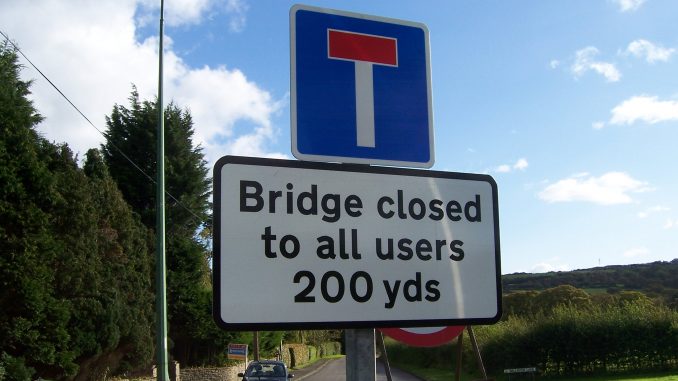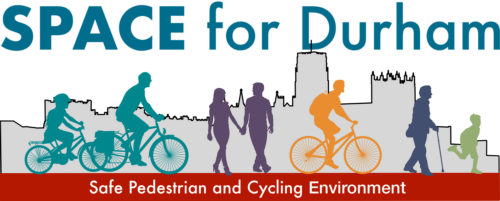
There are some strange and confusing things happening to the cycling provision in Langley Park. For a long time now, the bridge on Wallnook Lane has been “closed to all users.”
That’s because the bridge is falling down. It’s a shame, because anyone wanting to cycle from Langley Park to Witton Gilbert (and thence to Durham) could use this to avoid the fast and busy Front Street link to the Red Tile roundabout. At the same time, signs like this have appeared at either end of the bridge on Front Street….

This is particularly strange, as the path over the bridge is not designated as a cycle path (and certainly not a bridleway). In fact, a sign at the Red Tile end of the road clearly prohibits cycling.

Durham Council may well want to read this article about its northern neighbour, which fell foul of the law in putting “Cyclists Dismount” signs on the highway:
There’s plenty of room on either side of Front Street to build a nice, segregated cycle path but this hasn’t happened either.
What’s even stranger is that if you ignore the “no traffic” signs on Wallnook Lane, you will find, when you reach the bridge, that it is not in fact “closed to all users”. Someone – we assume the Council – has done this:

Yes, you can walk, or steer a bike, over it. So why tell people they can’t? Sort out the signage, remove the fence at the end and the ugly concrete block beyond, install some permanent bollards, and this lane could be one of the first rural roads in County Durham to be filtered to remove through motor traffic. Many rural roads in the Netherlands are filtered in this way. By forcing the motor traffic to stick to the main roads, a network of quiet routes for cycling, horse-riding and walking can be created, where the only motor traffic you will see is accessing properties along the road. In the 1930s, Wallnook Lane was the only link from the A691 to Langley Park. When the new, faster link road was built, Wallnook Lane could have been filtered to prevent through motor traffic. Now that the weak bridge has forced the closure, the Council should take advantage of it to benefit cycling.
Meanwhile, at the Red Tile roundabout, a nice new pavement has been built, presumably at some expense to the public, leading up the hill, past the bus stop. It serves a few houses on the Lanchester Road and leads to the junction for the Langley Park Industrial estate.

We’ve seen much narrower and busier pavements designated as multi-user paths in Durham so it wouldn’t seem unreasonable to allow cycling on this, especially when the adjacent road has a speed limit of 60mph … but no, because the new path is narrow, the council has solved the problem by erecting a “no cycling” sign. What a pity they did not consider the current Highways England design guidance for cycling, which requires that new roads with a speed limit of 40 mph or more must have protected space for cycling away from the motor vehicles. If the council was serious about accommodating cycling they would have built the new path wider.
By contrast, at Red Tile roundabout, you are permitted to cycle into this hedge:

It’s a wonderful, topsy turvy world in County Durham Highways. Coming next, how Durham County Council is solving the problem of speeding drivers – by raising the speed limit!

Been there done it and bought the T-shirt, completely bonkers and you know at the end of the day we are paying these guys to run our county this way, what a waste….
Completely bonkers – just to clarify that at Wallnook Bridge – if you dismount its possible cross the bridge with your bike ? in which case why haven’t they just designated it a cycle/pedestrian horse route – otherwise as you say its a simple cheap job and plenty of space to make a nice wide path along front street
Yes, indeed, you can cross the bridge on Wallnook Lane with your bike, and you may be able to ride it carefully depending on the width of your handbars and your technique. Replacing the concrete blocks and the railings at the end of the bridge with bollards would be a great improvement for cycling and horse riders.